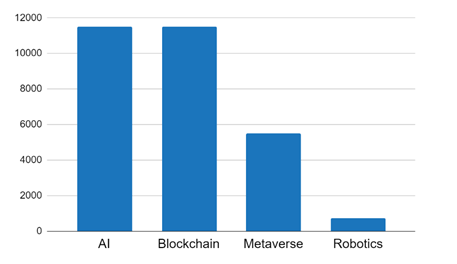In six short months, ChatGPT propelled artificial intelligence (AI) into the minds and imaginations of the masses more than any other development since the term “AI” was coined in 1956. According to research sponsored by techradar.pro, an astonishing 39% of U.S. and U.K. adult web users surveyed have used one or more generative AI tools.
With media outlets racing to get exclusives out the door on the latest “big thing,” sifting through the excitement to find the bigger picture is challenging. To gain perspective, Iron Mountain sponsored research by Quadrant Strategies, which used digital listening technologies to study public online conversation trends among enterprise decision-makers. The industries these decision-makers represented include insurance, banking, healthcare and life sciences, government, entertainment, and energy in the U.S. The listening centered on conversations about emerging technologies and use cases associated with innovation, such as artificial intelligence, metaverse, blockchain, robotics, Web 3.0, and tokenization.
AI surpassed other technologies in conversations about innovation
The research underscores that AI is leading the way in accelerating innovation. Conversations suggest that AI is already transforming most major industries. It surpasses blockchain and metaverse projects, which are viewed as experimental or in the pilot stage, especially by established enterprises. Further analysis shows that AI and blockchain drive over 50% of discussions about innovation across all the industries we studied, as illustrated below.

Top Technologies Mentioned in Innovation Conversations
Tweets from Verified Accounts, January 2021 – December 2022
Opportunities abound for innovating with AI. McKinsey & Company’s 2022 Global Survey on AI says, “AI adoption globally is 2.5x higher [in 2022] than in 2017.” The inherent capabilities of AI–to process vast amounts of data and use learned intelligence to make decisions with extraordinary speed–enable opportunities uncovered through digital listening. At the same time, ongoing challenges continue to be voiced online. We’ve detailed the key points from our listening research below.
AI Opportunities
- Generative AI is the basis for sophisticated AI models such as ChatGPT and Dall-E. These tools are disrupting creative industries and provide the basis for next-generation search engines and chatbots.
- Automation is viewed by technology leaders as a pathway to automate decision-making across various use cases, helping organizations increase workflow efficiencies.
- Big Data collection at scale is increasing across industries, presenting opportunities for companies to develop AI models and leverage insights from that data.
AI Challenges
- Transparency: Experts warn that, to build trust, AI systems must be explainable and provide independent, third-party verification of decisions and processes. This helps to ensure accuracy and neutrality.
- Ethics and Bias: Civil society groups and consumer advocates warn that AI could perpetuate societal issues such as systemic bias and inequality or promote hate speech, mis/disinformation, and more.
- Regulation: Lawmakers worldwide are considering privacy legislation and other rules that could limit the scope of data collection and AI use cases. [Note: China recently issued rules for generative AI tools, including recent tools launched by Alibaba and Baidu.]
Blockchain continues to be an important innovation enabler
Blockchain is the second most popular technology topic tied to innovation in digital conversations we studied. Its algorithms and architecture make it resistant to tampering and, thus, ideal for storing financial records, medical data, or other sensitive information. Because transactions are transparent, blockchain has the potential to increase trust and enable new types of disruptive applications and services, such as decentralized financial systems, marketplaces, and social networks. Our digital listening revealed several opportunities and challenges, summarized below.
Blockchain Opportunities
- Decentralization: Blockchain advocates hope to realign control of the Internet by taking away the power held by big technology companies seen as gatekeepers.
- Smart Contracts: Technology experts and investors believe that products built around smart contracts–code that executes when conditions are met–will significantly impact real-world applications.
- Data Storage: Computer scientists and programmers assert that blockchain offers certain advantages for data storage compared to alternatives.
- Non-fungible tokens (NFTs): Creators and artists are excited about the potential of using NFTs (which exist on a blockchain) to verify ownership of their works, profit from them, and enable other use cases such as event passes, crowdfunding, and more.
Blockchain Challenges
- Privacy and Security: The nature of blockchains as a public ledger presents personal privacy and security risks that likely limit the technology’s adoption in sensitive industries such as healthcare.
- Declining Value: Blockchain technology is inherently linked to the cryptocurrency industry that it spawned. Cryptocurrency has faced several setbacks, including crashing asset prices and scandals such as hacks and fraud.
- Environmental Concerns: Environmentalists often criticize the energy consumption of blockchain products, which leads to a high carbon footprint.
Metaverse experiences enable new ways of interacting
Metaverses are persistent, connected virtual spaces where users or visitors can immerse themselves in work, play, commerce, and socialization. In these spaces, virtual and physical worlds can be unified, and what happens in one world can affect the other. For example, transactions in a virtual world could be binding in the physical world. According to Marty Resnick, VP analyst at Gartner, “Emergent metaverses are in their infancy. But technology trends, with proven use cases and business outcomes, are just the beginning of the value technology innovation brings to the enterprise.”
Our digital listening uncovered the following opportunities and challenges related to metaverses.
Metaverse Opportunities
- Advertising: Advertisers see the metaverse as a powerful way to connect with and reach consumers.
- Gaming: Companies behind popular video games argue that their virtual worlds are the closest thing resembling a “metaverse” on the market.
- E-commerce: Metaverse developers view these experiences as another avenue for online shopping, either for real-world goods or accessories for virtual avatars.
- Virtual Work and Education: Organizations and educators believe virtual reality technology will enable immersive experiences such as meetings, training sessions, customer interactions, and site visits.
Metaverse Challenges
- Hardware Limitations: Virtual reality critics argue that industry-leading goggles are still too expensive and difficult to use based on their weight and haptic responses.
- Trust and Safety: Individuals and organizations critical of social media are turning their attention to the metaverse, scrutinizing and testing systems intended to promote privacy and child safety and protect against hate speech and harassment.
- Low Adoption: Industry analysts are skeptical that virtual reality worlds will achieve widespread adoption in the near future.
Accelerating innovation by addressing key issues
While AI, blockchain, and metaverse use cases and adoption vary by industry, we uncovered two overarching priorities. Universally, decision-makers care about protecting user security and privacy and avoiding introducing bias or exacerbating existing inequalities through automated systems. These two must-haves shape the adoption of new technologies and use cases.
Organizations can accelerate the adoption of data-dependent use cases such as those revealed through our research by having their data in order: using information governance to manage data across its lifecycle through processes, roles, controls, and metrics to collect, organize, use, and secure data. Information governance enables enterprises to achieve strategic goals, mitigate risk, and reduce costs.
Learn how to safeguard data and comply with changing laws, regulations, and operational requirements in Measuring Enterprise Information Governance Maturity.
About the Author
 Debra Slapak is a co-author of Compassion-Driven Innovation: 12 Steps for Breakthrough Success. She is Senior Director of Innovation Strategic Initiatives at Iron Mountain, where she leads the team responsible for the global enterprise innovation thought leadership and research programs. Debra has led marketing programs at Dell and IBM, crafting thought leadership research, education, and outreach in areas such as enterprise edge and 5G, artificial intelligence, data analytics, data management, sustainability, metaverses, and unified asset strategy. Throughout her career, she has engaged with customers, analysts, researchers, subject-matter experts, and strategists to illuminate innovation opportunities springing from emerging technologies. She’s a registered nurse, adventurous chef, therapy pet handler, wife and mother, pet lover, and natural gardener in the fertile wine country of central Texas.
Debra Slapak is a co-author of Compassion-Driven Innovation: 12 Steps for Breakthrough Success. She is Senior Director of Innovation Strategic Initiatives at Iron Mountain, where she leads the team responsible for the global enterprise innovation thought leadership and research programs. Debra has led marketing programs at Dell and IBM, crafting thought leadership research, education, and outreach in areas such as enterprise edge and 5G, artificial intelligence, data analytics, data management, sustainability, metaverses, and unified asset strategy. Throughout her career, she has engaged with customers, analysts, researchers, subject-matter experts, and strategists to illuminate innovation opportunities springing from emerging technologies. She’s a registered nurse, adventurous chef, therapy pet handler, wife and mother, pet lover, and natural gardener in the fertile wine country of central Texas.
Digital Transformation
Read More from This Article: Digital listening reveals 3 leading innovation drivers
Source: News


